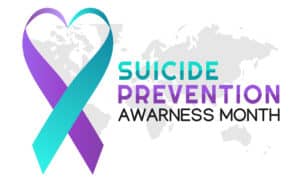Table of Contents
September is Suicide Prevention and Awareness Month
A recent business interaction allowed for dedicated time and serious reflection with regards to suicide awareness and the prevention of this far-reaching public health problem. Suicide has affected, is affecting, or will affect all of us at some point. With September being Suicide Prevention Awareness Month (SPAM), we want to be very clear about our support in raising awareness about suicide, the warning signs, and the means to obtain help to help prevent suicide.
First and foremost, if you or someone you know is struggling or in crisis, help is available. Call or text 988 or chat 988lifeline.org to reach the 988 Suicide & Crisis Lifeline.
The 988 Suicide & Crisis Lifeline is a national network of local crisis centers that provides free and confidential emotional support to people in suicidal crisis or emotional distress 24 hours a day, 7 days a week in the United States. We’re committed to improving crisis services and advancing suicide prevention by empowering individuals, advancing professional best practices, and building awareness (source).
According to the CDC, suicide is death caused by injuring oneself with the intent to die. A suicide attempt is when someone harms themselves with any intent to end their life, but they do not die as a result of their actions.
Many factors can increase the risk for suicide or protect against it. Suicide is connected to other forms of injury and violence. For example, people who have experienced violence, including child abuse, bullying, or sexual violence have a higher suicide risk. Being connected to family and community support and having easy access to health care can decrease suicidal thoughts and behaviors.
According to the National Alliance on Mental Illness (NAMI), suicidal thoughts, much like mental health conditions, can affect anyone regardless of age, gender, or background. In fact, suicide is often the result of an untreated mental health condition. Suicidal thoughts, although common, should not be considered normal and often indicate more serious issues (source).
Key Facts about this Public Health Crisis
- Suicide rates increased 30% between 2000–2018, and declined in 2019 and 2020
- Suicide is the 12th leading cause of death in the United States with 45,979 deaths in 2020 – approximately one death every 11 minutes
- In 2020, an estimated 12.2 million American adults seriously thought about suicide, 3.2 million planned a suicide attempt, and 1.2 million attempted suicide
- 79% of all people who die by suicide are male
- Although more women than men attempt suicide, men are 4x more likely to die by suicide
- In 2020, suicide was among the top 9 leading causes of death for people ages 10-64
- Suicide is the 2nd leading cause of death for people ages 10-14
- Suicide is the 3rd leading cause of death for people ages 15-24
- Suicide is the 2nd leading cause of death for people ages 25-34
- 46% of people who die by suicide had a diagnosed mental health condition, but research shows that 90% may have experienced symptoms of a mental health condition
- Annual prevalence of serious thoughts of suicide, by U.S. demographic group:
- 9% of all adults
- 3% of young adults aged 18-25
- 8% of high school students
- 45% of LGBTQ youth
Suicide rates vary by race/ethnicity, age, and other factors, such as where someone lives. By race/ethnicity, the groups with the highest rates were non-Hispanic American Indian/Alaska Native and non-Hispanic White populations. Other Americans with higher than average rates of suicide are veterans, people who live in rural areas, and workers in certain industries and occupations like mining and construction. Young people who identify as lesbian, gay, or bisexual have higher rates of suicidal thoughts and behavior compared to their peers who identify as heterosexual.

(Data from the CDC, NIMH, NAMI, and other select sources)
Far-Reaching Impacts of Suicide
Suicide and suicide attempts cause serious emotional, physical, and economic impacts. People who attempt suicide and survive may experience serious injuries that can have long-term effects on their health. They may also experience depression and other mental health concerns. The good news is that more than 90% of people who attempt suicide and survive never go on to die by suicide.
Suicide and suicide attempts affect the health and well-being of friends, loved ones, co-workers, and the community. When people die by suicide, their surviving family and friends may experience shock, anger, guilt, symptoms of depression or anxiety, and may even experience thoughts of suicide themselves.
Suicide Is Preventable through Education
Suicide is preventable and everyone has a role to play to save lives and create healthy and strong individuals, families, and communities. Suicide prevention requires a comprehensive public health approach. The CDC developed Preventing Suicide: A Technical Package of Policy, Programs, and Practices (also available in Spanish), which provides information on the best available evidence for suicide prevention. States and communities can use the technical package to help make decisions about suicide prevention activities. Strategies range from those designed to support people at increased risk to a focus on the whole population, regardless of risk.
Key Takeaways:
- Strengthen economic support
- Strengthen household financial security
- Housing stabilization policies
- Strengthen access and delivery of suicide care
- Coverage of mental health conditions in health insurance policies
- Reduce provider shortages in underserved areas
- Safer suicide care through systems change
- Create protective environments
- Reduce access to lethal means among persons at risk of suicide
- Organizational policies and culture
- Community-based policies to reduce excessive alcohol use
- Promote connectedness
- Peer norm programs
- Community engagement activities
- Teach coping and problem-solving skills
- Social-emotional learning programs
- Parenting skill and family relationship programs
- Identify and support people at risk
- Gatekeeper training
- Crisis intervention
- Treatment for people at risk of suicide
- Treatment to prevent re-attempts
- Lessen harms and prevent future risk
- Postvention
- Safe reporting and messaging about suicide
Summary
No matter how much pain you’re experiencing right now, you’re not alone. Many of us have had suicidal thoughts at some point in our lives. Feeling suicidal is not a character defect, and it doesn’t mean that you are crazy, weak, or flawed. It only means that you have more pain than you can cope with right now. With time and support, you can overcome your problems and the pain and suicidal feelings will pass. Some of the finest, most admired, needed, and talented people have been where you are now. Many of us have thought about taking our own lives when we’ve felt overwhelmed by depression and devoid of all hope. But the pain of depression can be treated, and hope can be renewed. If you need immediate help call or text 988.

